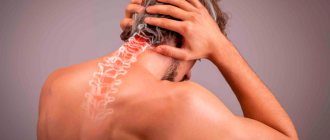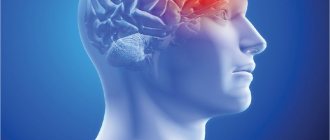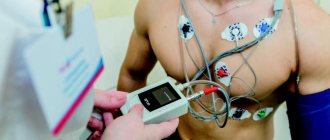It is worth understanding that any pain at the base of the skull should cause concern. This is a reason to immediately seek medical help. In the area of the main skull there is an exit through which the entire body is innervated. Paired cranial nerves immediately emerge, which are responsible for the functioning of the heart muscle, the formation of the solar plexus, etc.
Pain at the base of the skull may indicate inflammation of the sphenoid paranasal sinuses. Sphenoiditis is a serious pathology in which other clinical signs may be completely absent. Only an otolaryngologist can make such a diagnosis. Therefore, if after suffering from a cold you begin to experience pain at the base of the skull, be sure to visit an otolaryngologist and rule out this serious disease.
In most clinical cases, pain in the back of the head at the base of the skull is provoked by pathological changes in the structures of the cervical spinal column. This may be osteochondrosis, instability of the position of the vertebral bodies, poor posture and curvature of the spinal column.
The spine is divided into five main sections: cervical, thoracic, lumbar, sacral and coccyx. Each department has a number of distinctive features. The cervical spine consists of seven vertebral bodies. The very first vertebra and the second are connected to each other using a joint. There is no intervertebral disc here. This structure allows for maximum head mobility. Between the remaining vertebral bodies there are intervertebral cartilaginous discs. They provide reliable protection of the vertebral bodies from collision, guarantee the free passage of the radicular nerves through the foraminal openings and evenly distribute the shock-absorbing load.
Intervertebral discs consist of a dense membrane (annulus fibrosus) and a pulpous body inside it (nucleus pulposus). They do not have their own circulatory network. Most of the fluid and nutrition are obtained through the contraction of the surrounding muscles of the neck and collar area. When contracting, myocytes release fluid enriched with nutrients and oxygen. It is absorbed by the tissues of the fibrous ring. Partially diffuse nutrition occurs through exchange with the endplate, which separates the vertebral body from the intervertebral disc.
If a person leads a sedentary lifestyle, is engaged in mental sedentary work, during which the neck muscles are statically overstrained, then he begins to develop degenerative dystrophic damage to the cartilaginous tissue of the intervertebral discs. The lights lose their ability to provide protection and even distribution of shock absorption. Gradually, disc protrusion begins to develop, calcium salts are deposited on the vertebral bodies and growths (osteophytes) form.
The bodies of the cervical vertebrae have peculiar hook-shaped processes. They ensure safe passage of the posterior vertebral arteries inside the canal they create. These blood vessels provide nutrition to the posterior regions of the brain. When the hook-shaped vertebral processes are deformed or when the vertebral bodies are displaced, posterior vertebral artery syndrome develops. It can also cause severe pain at the base of the skull.
If you experience pain at the base of your skull, seek immediate medical attention from a neurologist. In Moscow, you can make an appointment for a free appointment with a neurologist right now. In our manual therapy clinic, the initial consultation is completely free for each patient. Take advantage of this opportunity - fill out the form to make an appointment with a doctor right now. The clinic administrator will contact you and agree on a time convenient for the visit.
Possible causes of headache on the right side
Pain in the right side of the head can occur due to various diseases and conditions. It is important to understand that it sometimes manifests itself in a healthy person and does not always indicate any violations. It can be sharp or aching, concentrated only on the right side of the head or spread over its entire surface, radiating to the neck, arms, shoulders or back.
The simplest causes of headaches on the right include physiological factors that periodically occur in every person.
- Stressful situations are one of the most common reasons for a headache on the right side. They are accompanied by the release of adrenaline into the bloodstream, which constricts blood vessels and causes an increase in blood pressure. Doctors at the Clinical Institute of the Brain recommend avoiding stress and ensuring proper rest, otherwise there is a risk of developing chronic hypertension.
- Excessive physical activity is another cause of pain on the right side of the head. After training or a busy day at work, characteristic signs appear: accelerated heartbeat, pain and discomfort in the chest, difficulty breathing. These are dangerous symptoms that indicate the need for rest.
- Bad habits can cause headache attacks on the right side. Smoking and alcohol abuse quickly worsen the condition of blood vessels and affect the functioning of the heart, reducing the speed of blood circulation in the brain. Atherosclerosis, hypertension and other diseases, as well as increased risks of stroke and heart attack can be a consequence of an unhealthy lifestyle.
- Coffee, tea, and energy drinks not only tone up, but also affect the condition of blood vessels. They narrow, which can lead to an attack of hypertension, rapid pulse and acute pain in the right side of the head.
At home, you can lead a healthy lifestyle, choose healthy foods and exercise. Taking care of the state of the cardiovascular system and physical training, as well as getting enough sleep and regular rest will help avoid pain in the right side of the head. However, during diagnosis, more serious causes of headaches in the right hemisphere may be detected - they require complex treatment, which can be obtained at the Clinical Brain Institute.
Migraine
Migraine is an attack of headache, usually one-sided. The exact cause that causes it remains unknown, but a hereditary predisposition has been found. Migraines can also appear in adulthood as a result of injuries, falls, concussions, and vascular diseases. During an attack, the patient has a headache on the right or left, and general health, performance, and concentration deteriorate. Often the overall picture is preceded by a “migraine aura” - a set of characteristic symptoms that can be used to determine the imminent onset of acute pain. These include:
- nausea, vomiting;
- increased sensitivity to bright lighting, tearing eyes;
- feeling of numbness, trembling of the hands;
- deterioration of hearing and vision.
A headache in the right hemisphere of a migraine can spread over the entire surface of the head, and also spread to the arms, neck and shoulders. The attack can last from several hours to several days. According to statistics, migraines occur more often in women. Painkillers will help reduce symptoms, but after their effect wears off, the pain returns.
Intracranial pressure
Intracranial pressure is represented by several types of fluids, including blood and the contents of the cerebral ventricles, as well as the brain. It is impossible to measure this value at home, and the diagnosis is made based on characteristic symptoms:
- headache in the right hemisphere, back of the head or temples - it is acute, throbbing, and can spread to the entire surface of the head;
- pain in and behind the eyes;
- nausea and vomiting, general deterioration of health.
With increased intracranial pressure, pain on the right side of the head radiates to the temples and often has a girdling character. Its intensity depends on the cause of hypertension. This symptom can appear one-time, due to stress, strain, or lack of oxygen in the room. Frequent attacks of headaches in the right side of the head, which are associated with pressure, require more detailed diagnosis and may indicate cerebral circulatory insufficiency.
Cluster headaches
Cluster headaches are the rarest, but at the same time the most intense type. Their exact cause is unknown. This type of pain in the right area of the head is accompanied by additional symptoms:
- drooping of the upper eyelid;
- difficulty breathing, shortness of breath;
- redness of the skin, sweating;
- lacrimation in one or both eyes, pain, increased sensitivity to light.
Acute pain in the head on the right, left, or along its entire surface lasts for 5–10 minutes, then it becomes less intense and persists for several hours. Cluster pain can occur daily, over a long period of time (several months) at specific times.
Headache on the right side due to tonsillitis
Infectious tonsillitis (tonsillitis), as well as other viral and bacterial colds, can cause headaches on the right side. It is often one-sided and appears in the half on which the inflamed tonsils are located. The patient also exhibits additional symptoms common to influenza, ARVI and other colds:
- temperature increase;
- general weakness, muscle aches;
- swelling in the throat and pain;
- nasal congestion.
A characteristic sign of tonsillitis is enlarged tonsils. This results in a severe sore throat and difficulty swallowing. White spots or plaque may be visible on them - foci of bacterial purulent infection.
Injuries and their consequences
An acute headache on the right side of the head can occur with a severe injury or fall. Bleeding from the vessels that supply the brain provokes the formation of hematomas, which put pressure on the nerve tissue. Symptoms of a traumatic brain injury may vary depending on the location of the injury and the severity of the impact:
- sharp pain in the head on the left or right side, in the temples or on the back of the head;
- impaired coordination of movements;
- incomprehensible speech, unusual behavior;
- visual defects: swelling, changes in head shape, wounds;
- nausea, vomiting, fainting;
- pain on the right side of the head radiates to the ears.
Traumatic brain injuries cannot be treated at home. They can lead to memory loss and other dangerous complications. If the right side of your head hurts due to a strong blow, it is recommended to consult a doctor immediately.
Concussion
A fall or blow can also cause a concussion. This is a disruption of its functioning that causes loss of consciousness, and in some cases short-term amnesia. If the concussion occurs on the right side, it is accompanied by pain in the right hemisphere of the head, nausea, dizziness, blurred vision and hearing, and loss of coordination. Painful sensations can persist for a long time and recur in the future, in response to physical activity, weather changes and other factors.
Stroke
Stroke is an acute disorder of cerebral circulation. This is a dangerous condition that requires emergency medical attention and poses a threat to the patient's life. The most common type is ischemic stroke. It occurs when there is insufficient oxygen supply to the brain. Its causes may be obstruction or compression of the arteries, low intracranial pressure, blood clots and other factors in which the flow of blood to the nerve tissues is stopped. It can be determined by the following characteristics:
- sharp pain in the head on the right or left;
- impaired coordination and symmetry of movements, deterioration of memory and attention;
- redness, pallor or blueness of the mucous membranes;
- muscle paralysis, decreased sensitivity of the skin in one part of the body.
A stroke occurs suddenly, but sometimes an attack can be recognized several hours before it worsens. At risk are men and women over 50 years of age with chronic heart and vascular diseases. An attack can also be triggered by excess weight, abnormalities of the arteries and atherosclerosis, irregular work hours and lack of rest, as well as bad habits: smoking and alcohol abuse.
The cause of a headache on the right or left, which occurs suddenly and is of high intensity, may be a hemorrhagic stroke. It is more dangerous to human life because it is a hemorrhage into the cerebral ventricles or the spaces between the membranes. An attack occurs when an artery supplying the brain ruptures and in most cases leads to loss of consciousness. The main task in case of hemorrhagic stroke is to seek emergency help as quickly as possible, but this does not guarantee a positive outcome.
Neoplasms
One of the causes of pain on the right side of the head is brain tumors, so it is always worth undergoing additional examination if this symptom occurs frequently. The danger is that the pain may not be too intense even with large or fast-growing tumors. Then they intensify, appear more often and become more acute. In addition, doctors at the Clinical Brain Institute recommend undergoing periodic examinations regularly - tumors in the initial stages may not cause pain or other symptoms.
Neck diseases
In the neck area there are important vessels that feed the brain and saturate its cells with oxygen. With some injuries and diseases, the movement of blood through the vessels becomes difficult, which is accompanied by headache attacks. There are several disorders that are often diagnosed in patients with chronic pain in the right side of the head:
- osteochondrosis is a disease of the intervertebral discs associated with a violation of their nutrition, in which the cartilage tissue becomes less elastic and elastic;
- protrusion - protrusion of intervertebral cartilage, often in the lateral direction (hernia is the terminal stage of protrusion);
- curvature of the spine - scoliosis of the cervical spine causes disruption of the blood supply to the brain;
- displacement of individual vertebrae is the result of injuries or weakness of the muscles of the cervical spine.
For pain in the neck that radiates to the head and arms, it is important to undergo an examination. X-rays will show the affected areas, type and stage of the disease. Based on these data, the doctor decides on the method of treatment.
Chronic paroxysmal hemicrania
Another cause of headaches on the right side of the head is chronic paroxysmal hemicrania. This is a rare autonomic disorder in which severe unilateral headaches are combined with other symptoms (nausea, photophobia, constriction of the pupils, drooping of the upper eyelid). Sharp pain in the right side of the head is often located in the temples. An acute attack lasts on average 10 minutes, but its duration can range from 5 to 40 minutes. During an exacerbation of the disease, up to 40 attacks per day can occur, in most patients - up to 5 to 10.
Meningitis
Pain in the head on the right side from above, in the temple or back of the head, which over time becomes acute and spreads over its entire surface, may be the first sign of meningitis. This is a dangerous infectious disease that affects the meninges and requires timely comprehensive treatment. The disease can be determined by the results of laboratory tests, as well as by characteristic signs:
- pain in the right side of the neck and head;
- nausea, vomiting;
- temperature rise to high levels;
- impairment of memory, consciousness, concentration;
- reduction of pain sensitivity;
- Herpes may appear in the mouth and other mucous membranes.
Meningitis can cause dangerous complications even if promptly diagnosed and treated. Nerve cells damaged as a result of infection propagation are not restored, and areas of necrosis appear in the membranes and cortex of the brain. The clinical picture differs depending on the location and size of the affected area. These may be mental, motor or sensory disorders, nervous tics and other complications, developmental delays in children. Cases of death cannot be ruled out either.
Costen's syndrome
Costen's syndrome is a rare, specific disease that is caused by dysfunction of the temporomandibular joint and jaw. It can appear only on the left or right side, as a result of which the pain will also be one-sided. Patients complain of typical symptoms:
- the right side of the head, arm and half of the neck hurts - symptoms intensify during exacerbation of the disease and decrease during periods of remission;
- fatigue, soreness, crunching while chewing;
- pressing pain on the right or left, which manifests itself during active and passive movements in the temporomandibular joint, as well as when pressing on this area;
- limited jaw movements, the patient is unable to open his mouth wide.
Patients with Costen syndrome often have additional symptoms caused by the underlying disorder. Thus, changes in bite, bruxism, one-sided abrasion of dental surfaces, and incorrect placement of teeth in the oral cavity are characteristic.
Pain in the muscles of the base of the skull
Sharp pain at the base of the skull may be associated with muscle fiber overstrain. If the appearance of this symptom was preceded by prolonged work at the computer and being in an uncomfortable static position, then there is a high probability of developing myositis. This disease can also occur against the background of sudden hypothermia in the neck and collar area.
Pain in the muscles of the base of the skull can be a concomitant clinical symptom of developing cervical osteochondrosis. When the tissues of the cartilaginous intervertebral discs are damaged, their height decreases. In this case, the body triggers compensatory muscle tension in order to cut off the protection of the radicular and paired cranial nerves from compression when adjacent vertebral bodies converge.
Therefore, when pain appears that radiates to the base of the skull, it is necessary first of all to examine the cervical spine. First, a series of x-rays are ordered. They can show a decrease in the height of the intervertebral discs, displacement of the vertebral bodies, their torsion and rotation, the formation of cornerstone osteophytes and other indirect signs of the development of degenerative dystrophic disease of the spinal column.
If necessary, an ultrasound scan is prescribed - with the help of this examination, you can assess the condition of the posterior vertebral arteries, the degree of their patency and functionality. The doctor may also recommend MRI and CT examinations, EEG, etc.
Headache on the right side - diagnostic methods
It is important to determine the exact cause of the headache on the right side. This is impossible at home, so it is better to consult a doctor at the first alarming symptoms. The Clinical Institute of the Brain has developed general and individual programs for diagnosing headaches on the right side of the head, as a result of which it is possible to differentiate between strokes, neoplasms, infectious and chronic diseases, as well as analyze herbal disorders.
If the right side of the head hurts, the following examination methods may be required:
- X-ray of the cervical spine;
- Dopplerography - ultrasound diagnostics of the vessels of the head, which will allow you to assess the degree of blood supply to the nerve tissues;
- encephalography - studies of the electrical potential of individual areas of the brain;
- Magnetic resonance and computed tomography are one of the most informative methods for detecting tumors, cysts, areas of necrosis and other abnormalities in brain tissue;
- laboratory blood tests to determine infectious diseases.
Based on the diagnostic results, treatment is prescribed. The course is selected separately for each patient and will be most effective if the exact cause of pain and disorders caused by the underlying disease are determined. If painful sensations in the area of the right side of the head, neck, forehead occur once and do not recur, a full examination is not necessary. It is enough to monitor your health on your own and consult a doctor if the attack recurs.
Diagnostics
Diagnostic measures are carried out by a neurologist. If necessary, an infectious disease specialist, therapist, surgeon, and other specialists are involved in the examination. The purpose of the conversation with the patient is to clarify complaints, study the nature of the headache, and collect anamnestic data. The results of an external examination are often uninformative. In case of injuries, wounds, abrasions, local swelling, and bruises are found. In case of vascular pathologies, an increase or decrease in blood pressure is determined.
Assessment of the somatic status, identification of various syndromes (intoxication, infectious-toxic, characteristic of impaired renal function and respiratory system) allow us to suggest a possible cause of the symptom and determine the direction of further examination. The following techniques can be used:
- Neurological examination
. Muscle strength, sensitivity, and reflexes are assessed. The study is informative for meningitis, arachnoiditis, encephalitis, intracranial hypertension, and in the late stages of atherosclerosis. - X-ray of the skull.
Most indicative of injuries. Allows you to avoid damage to hard structures (fractures of the arch and base). In chronic intracranial hypertension, including in patients with arachnoiditis, osteoporosis of the dorsum sella and digital impressions are detected. - Electroencephalography.
Performed to identify and assess the severity of brain dysfunction. With convexital arachnoiditis, it may indicate the presence of foci of epileptogenic activity. - Ultrasonic methods
. Echoencephalography is used at the initial stage of the examination. It is mandatory for suspected TBI; it makes it possible to quickly confirm displacement of midline structures, cerebral edema, and hydrocephalus. Duplex and Doppler ultrasound are recommended for the study of cerebral circulation. - and MRI.
They are clarifying diagnostic methods. They are performed to assess the structure of brain tissue, determine the location and nature of focal changes. Contrast studies are effective in vascular diseases. - Lumbar puncture.
It is used to confirm meningitis, arachnoiditis, hydrocephalus of various origins, and to clarify the characteristics and severity of TBI. The resulting cerebrospinal fluid is sent for microscopy, PCR is performed according to indications, and inoculation is carried out on nutrient media. - Lab tests
. They help assess the condition of the body, diagnose atherosclerosis, inflammatory diseases, and general infections. If the symptom has an allergic etiology, special tests are performed to identify the allergen.
Consultation with a neurologist
Treatment of right-sided headaches
Treatments for right-sided headaches will vary depending on the cause. Tactics are aimed at eliminating both the underlying disease and its symptoms to make the patient feel better. The Clinical Brain Institute offers inpatient treatment, recovery after stroke, and observation after injury and concussion. The treatment regimen may include several stages:
- drug treatment: painkillers, anti-inflammatory and vasodilator drugs, medications to improve heart function, specific therapy for infectious diseases;
- additional techniques: massage, gymnastics, physiotherapy;
- surgical treatment is required only if tumors, hematomas, cysts and neoplasms are detected that are prone to growth and interfere with the normal functioning of the brain;
- specific schemes for stroke and traumatic brain injury, aimed at restoring nervous activity.
The Clinical Brain Institute specializes in the diagnosis and treatment of pain that occurs on the right side of the head. There are all the necessary conditions for patient examination, instrumental and laboratory diagnostics, hospital treatment and constant supervision by specialists. Doctors warn: frequent attacks, during which there is a headache and nausea, additional symptoms appear, require timely examination. In the early stages, treatment will be simpler, take less time and prevent complications.
Clinical Brain Institute Rating: 5/5 — 4 votes
Share article on social networks







